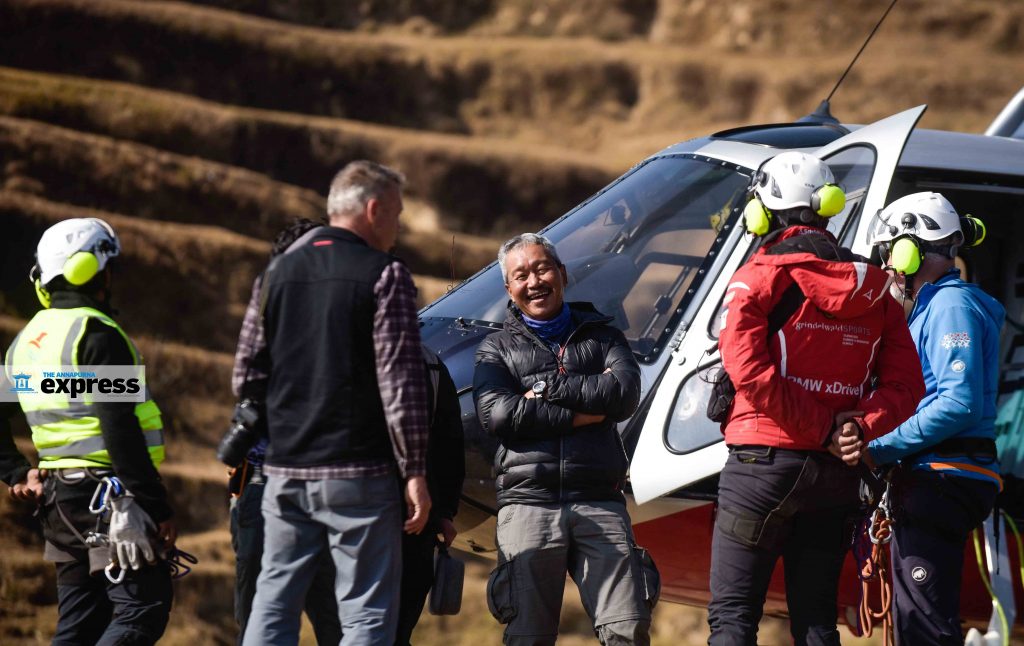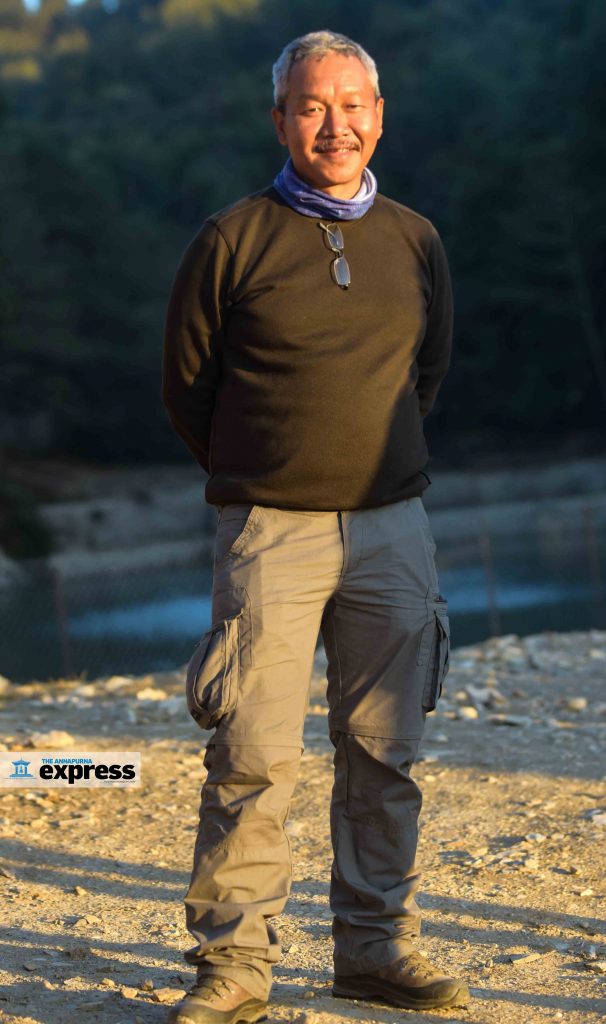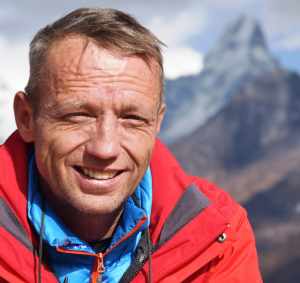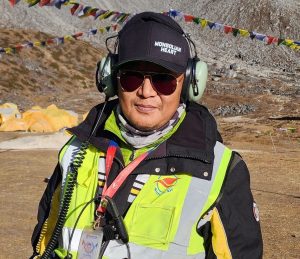Capt Siddartha Jang Gurung: Aviation rescue specialist

Completed flight course from Florida Flight Academy, US
Started rescue flights from 1995
Husband of Sraddha Gurung
Father to Devanshi Gurung and Shlok Jung Gurung
 I have been flying helicopters for 27 years now, and have a long experience of flying in the mountainous terrain of Nepal. I started as a co-pilot in Nepal Airways Helicopter Service in 1994 and have worked in five companies since.
I left Nepal Airways after two years to join Manakamana Helicopters. But Manakamana Helicopters stopped operation after two years, so I started flying with Karnali Air. I worked with Karnali Air for 10 years, and learned a lot there. Unfortunately the company shut down as well, and my job took me to Fishtail Air. I joined Simrik Air in 2011, where I work as the executive director.
So, my career in the aviation sector has been quite long and with many airlines. I wouldn’t have been in this industry had it not been for Narayan Singh Pun, a former Nepal Army pilot. I met Pun when I was a young boy in Britain, where my father, also an army officer, was posted at the Nepali Embassy as a military attaché.
My ancestral home is Lamjung and I was born in Lalitpur. I was 13 when I went to the UK with my family. My father used to entertain many Nepali guests at our residence, and one of them was Pun. It was Pun who inspired me to become a pilot. He advised me to take basic helicopter training in Britain and join the army as a pilot.
After completing the pilot training in the US, I was looking forward to joining the army, but my father, who had retired as a Brigadier General by then, advised me against becoming a military pilot. He told me that it was a difficult job.
So, I joined private airlines instead. And when Pun started Karnali Air, I went to work with him. I worked there for a decade. My journey in mountain rescue started in 2009. Before that, Nepal had only a handful of helicopters that could only fly at an altitude of around 4,000 meters. High altitude air rescue scene in Nepal changed after Fishtail Air brought B3 helicopters, which could go up to 7,000 meters.
I can still remember when a Slovakian climber got stuck in Langtang in 2009, and needed to be rescued. But we had no training, nor the equipment to extract him from the mountains. So, a Swiss rescue team was called in, and they collaborated with Fishtail Air for the rescue. It was agreed that a Nepali pilot would conduct the rescue under the supervision of the Swiss team. That Nepali pilot was none other than my dear friend Capt. Sabin Basnet. The team located the climber but he had already died in the mountains. His body had to be carried out from the mountains. This is how the first technical rescue was performed in Nepal.
Understandably, it was not possible for international rescuers to come to Nepal for every rescue. So, the Swiss team decided to train three pilots, including Basnet and me. That’s how I became a rescue pilot.
I have been flying helicopters for 27 years now, and have a long experience of flying in the mountainous terrain of Nepal. I started as a co-pilot in Nepal Airways Helicopter Service in 1994 and have worked in five companies since.
I left Nepal Airways after two years to join Manakamana Helicopters. But Manakamana Helicopters stopped operation after two years, so I started flying with Karnali Air. I worked with Karnali Air for 10 years, and learned a lot there. Unfortunately the company shut down as well, and my job took me to Fishtail Air. I joined Simrik Air in 2011, where I work as the executive director.
So, my career in the aviation sector has been quite long and with many airlines. I wouldn’t have been in this industry had it not been for Narayan Singh Pun, a former Nepal Army pilot. I met Pun when I was a young boy in Britain, where my father, also an army officer, was posted at the Nepali Embassy as a military attaché.
My ancestral home is Lamjung and I was born in Lalitpur. I was 13 when I went to the UK with my family. My father used to entertain many Nepali guests at our residence, and one of them was Pun. It was Pun who inspired me to become a pilot. He advised me to take basic helicopter training in Britain and join the army as a pilot.
After completing the pilot training in the US, I was looking forward to joining the army, but my father, who had retired as a Brigadier General by then, advised me against becoming a military pilot. He told me that it was a difficult job.
So, I joined private airlines instead. And when Pun started Karnali Air, I went to work with him. I worked there for a decade. My journey in mountain rescue started in 2009. Before that, Nepal had only a handful of helicopters that could only fly at an altitude of around 4,000 meters. High altitude air rescue scene in Nepal changed after Fishtail Air brought B3 helicopters, which could go up to 7,000 meters.
I can still remember when a Slovakian climber got stuck in Langtang in 2009, and needed to be rescued. But we had no training, nor the equipment to extract him from the mountains. So, a Swiss rescue team was called in, and they collaborated with Fishtail Air for the rescue. It was agreed that a Nepali pilot would conduct the rescue under the supervision of the Swiss team. That Nepali pilot was none other than my dear friend Capt. Sabin Basnet. The team located the climber but he had already died in the mountains. His body had to be carried out from the mountains. This is how the first technical rescue was performed in Nepal.
Understandably, it was not possible for international rescuers to come to Nepal for every rescue. So, the Swiss team decided to train three pilots, including Basnet and me. That’s how I became a rescue pilot.
 I can still remember the second rescue mission of 2010. Two foreigners were stuck on the north side of Camp 3 of Ama Dablam at 21,000 feet. My friend Basnet went to rescue them, but he and his crewmate Engineer Purna Awale died in a crash before they could reach the rescue site. So, it was upon me and Capt. Ashish Sherchan to bring the bodies back and rescue the foreigners. It was my first mountain rescue mission, and a quite difficult one mentally and emotionally. I didn’t fly for a month after the incident.
When I got back to flying, I started participating in rescue training courses and performing rescue missions regularly.
I was also deployed to rescue the Taiwanese couple, who had gone missing in Rasuwa for more than a month, in 2017. They had fallen off a cliff and into a ravine. When my team reached there, we found the young man alive but his partner had died. When you are a rescue pilot, you come across many incidents like this.
I was also involved in several rescue missions after the 2015 earthquakes. As the Nepal Army had only one rescue helicopter, private sector helicopters were also deployed to lift off the injured people to hospital.
The aviation culture in Nepal, particularly the rescue flights, started late, but it is growing. I am currently active in regular passenger flights and rescue flights. I am also a certified rescue instructor. I currently fly Airbus H125 and Bell47 helicopters. Flying in Nepal’s mountains requires technical skills and experience. It is a risky job but I personally find it immensely rewarding, as I get to help those who are in distress.
I can still remember the second rescue mission of 2010. Two foreigners were stuck on the north side of Camp 3 of Ama Dablam at 21,000 feet. My friend Basnet went to rescue them, but he and his crewmate Engineer Purna Awale died in a crash before they could reach the rescue site. So, it was upon me and Capt. Ashish Sherchan to bring the bodies back and rescue the foreigners. It was my first mountain rescue mission, and a quite difficult one mentally and emotionally. I didn’t fly for a month after the incident.
When I got back to flying, I started participating in rescue training courses and performing rescue missions regularly.
I was also deployed to rescue the Taiwanese couple, who had gone missing in Rasuwa for more than a month, in 2017. They had fallen off a cliff and into a ravine. When my team reached there, we found the young man alive but his partner had died. When you are a rescue pilot, you come across many incidents like this.
I was also involved in several rescue missions after the 2015 earthquakes. As the Nepal Army had only one rescue helicopter, private sector helicopters were also deployed to lift off the injured people to hospital.
The aviation culture in Nepal, particularly the rescue flights, started late, but it is growing. I am currently active in regular passenger flights and rescue flights. I am also a certified rescue instructor. I currently fly Airbus H125 and Bell47 helicopters. Flying in Nepal’s mountains requires technical skills and experience. It is a risky job but I personally find it immensely rewarding, as I get to help those who are in distress.
 About him
Capt Rameshwar Thapa (Senior Colleague)
About him
Capt Rameshwar Thapa (Senior Colleague)
Capt Siddartha is a very important character in Nepali aviation. From the time he started his career, carrying out rescue flights has been his priority. We are lucky to have him at Simrik. He is a humble, helpful and professional guy. He is also brilliant at managerial work. He is a driven individual, who is passionate about his job.
Daniel Brunner (Friend)
 I have been working with him for more than a decade now and being a helicopter pilot, I can say that he has contributed a lot in Nepali helicopter rescue fraternity. My team has been conducting rescue training for Nepali pilots and we always coordinate with Capt. Siddartha. It is so good to work with him. He is concerned about rescue missions, which is very important for a country like Nepal.
Ang Tashi Sherpa (Colleague)
I have been working with him for more than a decade now and being a helicopter pilot, I can say that he has contributed a lot in Nepali helicopter rescue fraternity. My team has been conducting rescue training for Nepali pilots and we always coordinate with Capt. Siddartha. It is so good to work with him. He is concerned about rescue missions, which is very important for a country like Nepal.
Ang Tashi Sherpa (Colleague)
 I have known Capt. Siddartha from the time he started his flying career. He is a brilliant pilot. Without him, many rescue missions would not have been accomplished in Nepal. I am a rescue specialist on the ground and coordinating with him is so easy. Working with him is a learning experience. He has trained many rescue pilots, for which we should all be grateful to him.
I have known Capt. Siddartha from the time he started his flying career. He is a brilliant pilot. Without him, many rescue missions would not have been accomplished in Nepal. I am a rescue specialist on the ground and coordinating with him is so easy. Working with him is a learning experience. He has trained many rescue pilots, for which we should all be grateful to him.
related news
Harry Bhandari: An inspiring tale of Nepali immigrant in the US
Sept. 14, 2023, 4:06 p.m.
Baburam Bhattarai: An analysis on Nepal’s underdevelopment
Sept. 4, 2023, 9:36 a.m.
Shyam Goenka: Institutionalizing free press and democracy
Aug. 29, 2023, 7:42 p.m.
Sunil Babu Pant: A guardian of LGBTIQA+ community
March 11, 2023, 10:01 p.m.
Usha Nepal: An inspiration to every working woman
Feb. 25, 2023, 9:42 p.m.
Anupama Khunjeli: A trailblazer banker
Feb. 19, 2023, 12:54 a.m.
Bhuwan Chand: Born to perform
Feb. 4, 2023, 6:36 p.m.
Dr Bhagawan Koirala: Man of heart
Jan. 28, 2023, 9:24 p.m.










Comments